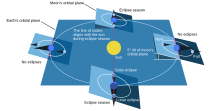
Back Temporada d'eclipsis Catalan Estación de eclipses Spanish Saison d'éclipses French ग्रहण ऋतु Hindi Сезон затемнень Ukrainian 食季 Chinese


An eclipse season is a period, roughly every six months, when eclipses occur. Eclipse seasons are the result of the axial parallelism of the Moon's orbital plane (tilted five degrees to the Earth's orbital plane), just as Earth's weather seasons are the result of the axial parallelism of Earth's tilted axis as it orbits around the Sun. During the season, the "lunar nodes" – the line where the Moon's orbital plane intersects with the Earth's orbital plane – align with the Sun and Earth, such that a solar eclipse is formed during the new moon phase and a lunar eclipse is formed during the full moon phase.
Only two (or occasionally three) eclipse seasons occur during each year, and each season lasts about 35 days and repeats just short of six months (173 days) later, thus two full eclipse seasons always occur each year. Either two or three eclipses happen each eclipse season. During the eclipse season, the Moon is at a low ecliptic latitude (less than around 1.5° north or south), hence the Sun, Moon, and Earth become aligned straightly enough (in syzygy) for an eclipse to occur. Eclipse seasons should occur 38 times within a saros period (6,585.3 days).
The type of each solar eclipse (whether total or annular, as seen from the sublunar point) depends on the apparent sizes of the Sun and Moon, which are functions of the distances of Earth from the Sun and of the Moon from Earth, respectively, as seen from Earth's surface. These distances vary because both the Earth and the Moon have elliptic orbits.
If both orbits were coplanar (i.e. on the same plane) with each other, then two eclipses would happen every lunar month (29.53 days), assuming the Earth had a perfectly circular orbit centered around the Sun, and the Moon's orbit was also perfectly circular and centered around the Earth. A lunar eclipse would occur at every full moon, a solar eclipse every new moon, and all solar eclipses would be the same type.
© MMXXIII Rich X Search. We shall prevail. All rights reserved. Rich X Search